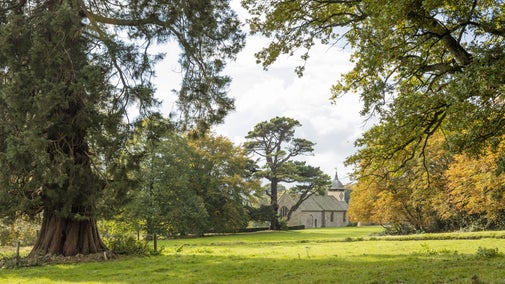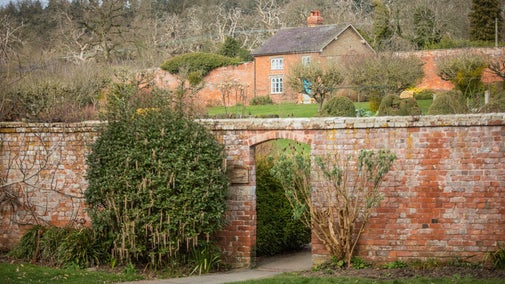
Donate
Everyone needs nature, now more than ever. Donate today and you could help people and nature to thrive at the places we care for.

Maintaining the 1,500 acres of woodland and parkland at Croft is an ongoing task. We’re undertaking regular, vital projects to restore, revive and conserve the historic parkland for current visitors and future generations. Discover more about the work we’ve been doing at Croft.
Since the 1930s, the UK has seen a dramatic loss of 97% of its wildflower meadows, causing significant harm to wildlife. Thanks to the generous support of Buglife and Herefordshire Meadows, we were part of a transformative project, 'Get the Marches Buzzing,' aimed at restoring meadowland at Croft Castle.
At Croft Castle, we focussed on three specific sections of land, strategically working to reconnect habitats. This initiative created a series of 'stepping-stones,' allowing wildlife to move freely through our landscapes instead of being confined to isolated areas. With proper management, these areas are evolving into wildflower-rich grasslands, appealing to both wildlife and people.
Restoring species-rich grassland is a gradual process, taking several years to fully settle and reach balance. Therefore, we continue with ongoing management to ensure the success of our initial groundwork and seed-sowing efforts. We are grateful for the support of our partners, volunteers, members, and visitors in preserving the rich natural heritage of this region.
'Get the Marches Buzzing' was funded by National Lottery Heritage Fund (NLHF), Milkywire, Edward Cadbury Charitable Trust and the Millichope Foundation. To learn more about the project, visit the Buglife website.
Croft is home to the largest collection of ancient trees in western Europe. Find out how we are caring for existing trees and planting new trees across the parkland.
Thanks to funding from Blue Diamond Garden Centres we are reinstating the lost former Oak Avenue which formed the original entrance approach to Croft. This will emphasise and celebrate the significance of the parkland design and heritage, as well as contributing to the legacy of Croft's veteran trees, planting the next generation of ancient trees at Croft.
As part of the project over two hundred oak trees have been planted by our rangers and their volunteer teams. They are protected from livestock with sweet chestnut tree guards, made with timber from our own woodlands at Pengethley.
Find out more about Blue Diamond Garden Centres collaboration with the National Trust: Blue Diamond Garden Centres
With ash dieback disease spreading quickly though Croft’s heavily wooded estate, action was taken to reduce potential risk to visitors from badly infected trees next to the footpaths shedding limbs and boughs, or even falling as they ‘died back’.
Work began in February 2020 to fell the most infected trees in Fishpool Valley and this continued from November 2020 to March 2021. The valley was closed until April 2021. Infected trees were felled and removed for safety reasons. Once the tree is infected, the disease is usually fatal.
Some areas of selective felling work was undertaken around the main drive and the castle, with most of the work occurring while the site was closed.
Plans to re-establish other native trees before ash became dominant such oak, chestnut, beech, lime and hornbeam, will help ensure resilience against diseases and climate change in the future. The trees selected for replanting have been carefully chosen from a local seed source and include many flowering and fruiting species to help attract a wide variety of wildlife to our woodland. Our ranger team have planted hundreds of trees in Fishpool Valley which will enhance biodiversity.
We have been working with Forestry England and Natural England since 2015 to reinstate historic wood pasture and restore wildlife.
Wood pasture is a mixture of open grown trees of various ages and clusters of trees. Rather than just grassland, the pasture contains patches of bracken and scrub, and it is grazed typically by cows.
Documented evidence shows the presence of wood pasture at Croft throughout the 18th and 19th centuries. During the 1950s, the Forestry Commission planted conifers that could quickly grow soft wood for the timber market.
As these conifers reached maturity and were ready to be harvested, Forestry England made a commitment to work with the Trust to enable the full restoration of the wood pasture. This has involved removing 28 hectares (70 acres) of non-native conifers from the central part of Croft Wood.
The National Trust ranger team then re-planted thousands of trees in the area, including broadleaved tree species such as oak, sweet chestnut, beech, hornbeam and field maple. With shrubby species to produce plenty of fruit and flowers such as hawthorn, elder, rowan, hazel, apple, plum and pear.
Ten years on from the beginning of the project see and hear how this landscape has changed over the years in this short film by wildlife cinematographer Tom Hartwell.
At Croft Castle in Herefordshire, the National Trust has been working with Forestry England for nearly 10 years to reinstate historic wood pasture and restore wildlife.
We ask for your permission before anything is loaded, as this content may introduce additional cookies. You may want to read the Google YouTube terms of service and privacy policy before accepting.
Alongside the wood pasture restoration project, other woodland areas are being restored.
Felling and re-planting work has been carried out in School Wood, which is a plantation on Ancient Woodland Site. This will help to improve the biodiversity for wildlife and turn it back into native woodland.
Trees planted are a mixture of sessile oak, common oak and bird cherry along with rowan, hazel, maple and lime trees.
We have completed an ambitious five-year restoration project in Fishpool Valley. The valley was remodelled in the early 19th century in the 'Picturesque' style. The stream was dammed to form a chain of artificial pools, and the valley sides were thickly planted with a mix of oak, ash, willow, poplar and evergreen species to suggest the 'bold roughness of nature'.
Thanks to supporters, the team have been able to restore the dams, sensitively thin some of the tree cover to improve biodiversity, open up lost views and conserve the historic structures in the valley, including a gothic pumphouse, ‘Picturesque’ grotto and limekiln. New walks have also been created through the landscape and you can now step inside the pumphouse for the first time in many years.
The ranger team have also been improving the drainage on the footpaths and restoring the woody edge of the paths to improve the intended natural shrub growth and redirecting canopy cover. Fishpool Valley is also a very tranquil spot for birdwatching. See if you can spot a variety of herons and moorhens to great spotted woodpeckers, sparrowhawks and other native woodland birds.
Read more about the Fishpool Valley restoration project
A biomass boiler and heating system helps provide 75 per cent of Croft Castle’s heating, saving 19,500 litres of oil per year as well as 52 tonnes of CO2.
The boiler is fuelled by woodchip from felled conifers, as these trees introduced after the Second World War are replaced by native broadleaves to encourage wildlife and biodiversity.

Everyone needs nature, now more than ever. Donate today and you could help people and nature to thrive at the places we care for.

Find out more about Blue Diamond Garden Centres collaboration with the National Trust.
Discover the conservation work preserving the historic castle at Croft.

Learn how the ‘Picturesque’ Fishpool Valley at Croft Castle was restored to its former natural glories.
Explore 1,500 acres of wood, farm and parkland including the 'Picturesque' Fishpool Valley and an Iron Age hillfort at Croft Castle.

Discover the garden at Croft Castle, taking in the historic orchard within the walled garden, or listen to the birds in the church garden.

Croft Castle was noted in the Domesday book in 1086 and the Croft family have played a part influencing British political and military history ever since. Uncover their stories in the castle.

Find out how the Croft family played their part in major historical events, and how Croft Castle eventually passed to the National Trust.
